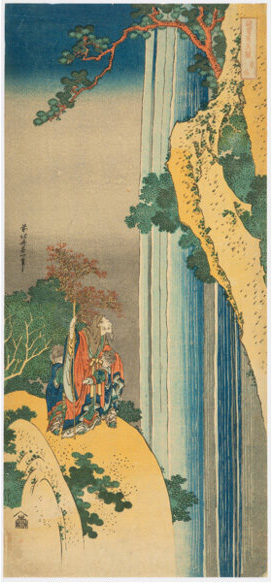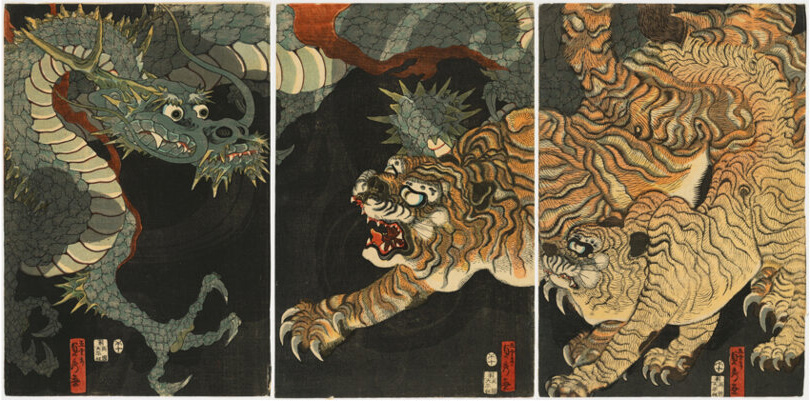|
|

|
Charlene's Picks
Charlene Wang | Acting Director, Asian Art | Business Development
|

|
Most people are familiar with Hokusai's Thirty-Six Views of Mount Fuji series, best known for its iconic The Great Wave and its rarity. However, his second rarest series, A True Mirror of Japanese and Chinese Poems (Shiika shashin kyō), is lesser known. This collection consists of ten upright illustrations depicting renowned poets from Japan and China.
This particular image portrays the famous Chinese poet Li Bo (also known as Li Bai, Li Peh, or Li Po, depending on the transliteration). Just as Hokusai called himself the "old man crazy to paint," Li Bo was famed for his unconventional and imaginative spirit. Here, he is depicted gazing at the towering waterfall of Mount Lu, his mind wandering into a realm of poetic fantasy. In his vision, the cascading water transforms into the Milky Way tumbling down from the heavens. So enraptured by this celestial spectacle, he leans forward in excitement, prompting his two young attendants to grasp his arms, preventing him from accidentally tumbling down in his trance-like awe.
This dynamic and expressive scene masterfully captures Li Bo's untamed poetic imagination, a trait that has cemented his legacy in both Chinese literature and Hokusai's artistic vision.
|
|
Steve Jobs was celebrated for his minimalist and elegant aesthetic, constantly pushing boundaries to make Apple products more modern, with balanced lines and refined shapes. A similar sense of harmony and simplicity can be found in the works of the shin-hanga movement, particularly those of Kawase Hasui. Jobs discovered Hasui's prints as a teenager and later became an avid collector.
This image, Okane Road, Shiobara by Hasui, is one of the images in Jobs' collection. The composition, a long vertical sheet, frames a winding road that guides the viewer's eye deeper into the scene, culminating in the glowing mountains in the distance. (lot #78155 in this auction is another imagery collected by Jobs)
This was Hasui's earliest published woodblock print and the first "test" collaboration between him and his publisher, Watanabe Shōzaburō. This initial project marked the beginning of their forty-year partnership, which would go on to shape the shin-hanga movement.
|
|

|
Megan's Picks
Megan Ma | Associate Specialist & Department Coordinator, Fine & Decorative Arts
|
|
This elegant print by Kinpōdō Nagao depicts Chang'E, the Moon Goddess in Chinese mythology, known for her legendary ascent to the moon after consuming the elixir of immortality. A central figure in Mid-Autumn Festival lore, she is often associated with themes of sacrifice, longing, and celestial beauty. In this composition, Chang'E is gracefully adorned in flowing robes, rendered in delicate shades of blue, exuding an ethereal presence. She cradles a white rabbit—her symbolic companion in lunar mythology—while another gazes up at her in quiet reverence. The large, glowing moon in the background reinforces the connection between Chang'E and the folklore surrounding the moon's mystique. Framed by an intricate orange border, this print beautifully captures the refined
elegance and poetic storytelling that characterize Japanese woodblock prints of surimono, seamlessly blending Chinese myth with a distinct ukiyo-e aesthetic.
|
|
|
Created after a painting by Yoshitoshi in 1882, this triptych print is widely regarded as one of his most renowned masterpieces, celebrated for its striking atmosphere and dramatic contrast. The central figure, Fujiwara no Yasumasa—a distinguished nobleman and flute player of the mid-Heian period—stands with unwavering composure as the wind sweeps through his flowing robe. This fluid motion starkly contrasts with his still, upright posture, while the assassin's tense stance and intense expression heighten the scene's dramatic tension. Fujiwara's absolute focus on his music, undisturbed by impending danger, makes his dedication all the more admirable. The colors in this print remain remarkably well preserved, with minimal discoloration. The vivid orange of his robe stands out
against the darkened night background, like a stream of light piercing through the darkness.
|
|

|
Hannah's Picks
Hannah Ziesmann | Cataloguer, Fine Arts
|

|
|
This electrifying woodblock triptych by Utagawa Sadahide captures a moment of primal tension, where myth and nature collide in a ferocious struggle. A sinuous dragon, its jade-green scales bristling with energy, coils through the darkness, its piercing gaze locked onto two raging tigers. The tigers, their fur ablaze with intricate, undulating stripes, lash out with bared fangs and razor-sharp claws, their bodies coiled like springs ready to pounce. The swirling black void behind them amplifies the intensity, as if the very air crackles with the force of their impending clash. This composition pulses with movement—Sadahide's masterful linework and dramatic contrast between the beasts heighten the visceral impact. The dragon and tiger, eternal rivals in Eastern mythology, embody the
balance of opposing forces: wisdom against raw power, sky against earth, the mystical against the tangible. With its exquisite detail and kinetic energy, this triptych is a breathtaking testament to Sadahide's skill in capturing the fierce, untamed spirit of the natural world.
|
|
|
These Ishizuri-e woodblock prints command attention with their stark black-and-white imagery, blending the fluidity of sumi-e brushwork with the crisp precision of stone rubbing technique. Each segmented vignette captures a moment of quiet drama: butterflies hover in midair, swallows dart and twist, reeds bend under an unseen wind. The Ishizuri method, mimicking stone-rubbings or the practice of creating an image of surface features on paper with pigments. creates an almost photographic intensity, where forms emerge from darkness with a ghostly, fleeting clarity. This high-contrast aesthetic sets Ishizuri apart from traditional ukiyo-e, replacing delicate tonal gradations with a bold interplay of positive and negative space. Floating inscriptions and artist seals weave through the
imagery, reinforcing ties to classical Japanese aesthetics even as the stark modernity of the prints reflects a shifting visual culture in the late Edo period.
|
|

|
|
Charlene Wang
Acting Director, Asian Art,
Business Development
CharleneW@HA.com
(212) 486-3731
|

|
|
Megan Ma
Associate Specialist &
Department Coordinator,
Fine & Decorative Arts
MeganM@HA.com
(214) 409-1196
|
|
|
|
|
|
|
|
|
|